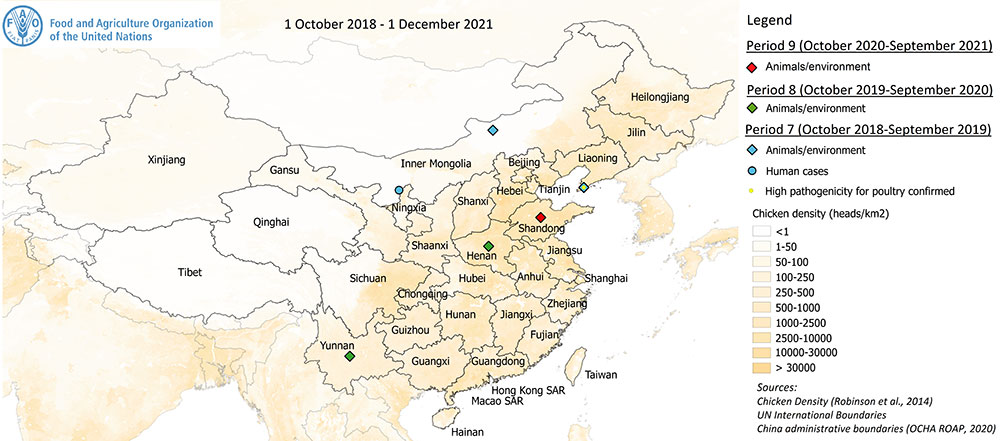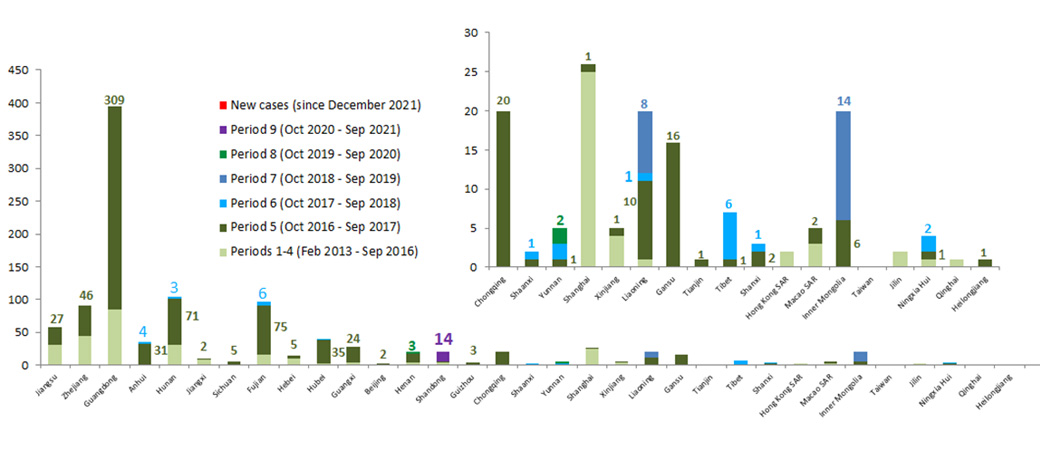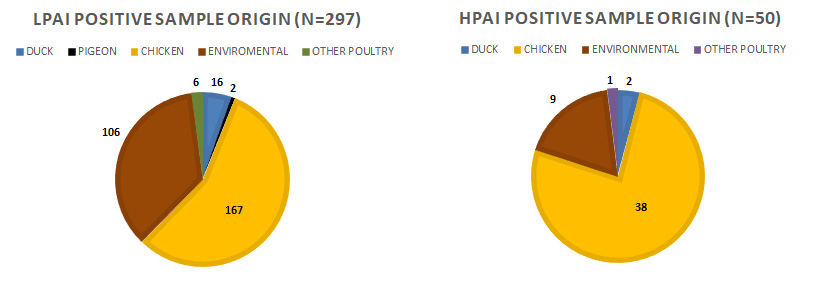
Animal health

1 June 2022, 17:00 hours; Rome
Overview
Hazard: Influenza A(H7N9) virus with pandemic potential.
Country: China; imported cases in Malaysia (1) and Canada (2).
Number of human cases: 1,568 confirmed; 616 deaths (since February 2013).
New findings in birds / environment since last update (01 December 2021):0
New human cases since last update (01 December 2021): 0
Map 1. Human cases and positive findings in birds or the environment in China

Note: Human cases are depicted in the geographic location where they were reported; for some cases, exposure may have occurred in a different geographic location. Centroid geo-coordinates were used for H7N9 positive animal/environment samples where the precise geolocation is unknown.
Provinces/municipalities affected (since 2013): Beijing, Chongqing, Shanghai and Tianjin Municipalities; Anhui, Fujian, Gansu, Guangdong, Guizhou, Hebei, Heilongjiang, Henan, Hubei, Hunan, Jiangsu, Jiangxi, Jilin, Liaoning, Qinghai, Shaanxi, Shanxi, Shandong, Sichuan, Taiwan, Yunnan and Zhejiang Provinces; Hong Kong SAR, Macao SAR; Guangxi, Inner Mongolia, Ningxia Hui, Tibet and Xinjiang Uyghur Autonomous Regions (China); Sabah (Malaysia); British Columbia (Canada).
Highly pathogenic virus findings: Since 10 January 2017, highly pathogenic avian influenza (HPAI) type H7N9 virus was detected in a total of 66 poultry or environmental samples (46 chickens, 8 peacocks, 2 duck and 10 environmental samples); H7N9 virus isolates from 32 human cases were found to be HPAI virus.
| Province | LBM* | Farm | Backyard | Others** | Total |
|---|---|---|---|---|---|
|
Anhui |
0 |
1 |
0 |
0 |
1 |
|
Fujian |
1 |
0 |
0 |
0 |
1 |
|
Guangdong |
22 |
0 |
0 |
0 |
22 |
|
Guangxi |
0 |
1 |
0 |
0 |
1 |
|
Hebei |
0 |
1 |
0 |
0 |
1 |
|
Heilongjiang |
0 |
1 |
0 |
0 |
1 |
|
Henan |
0 |
1 |
0 |
0 |
1 |
|
Hunan |
3 |
1 |
1 |
0 |
5 |
|
Liaoning |
0 |
1 |
0 |
1 |
2 |
|
Inner Mongolia |
0 |
2 |
0 |
0 |
2 |
|
Ningxia Hui |
0 |
2 |
0 |
0 |
2 |
|
Shaanxi |
0 |
2 |
0 |
0 |
2 |
|
Shanxi |
0 |
1 |
0 |
0 |
1 |
|
Tianjin |
0 |
1 |
0 |
0 |
1 |
|
Unknown |
0 |
0 |
0 |
1 |
1 |
|
TOTAL |
26 |
15 |
1 |
2 | 44 |
*LBM: live bird market; **Others include one airport and one zoo.
Situation in animals
- On 27 January 2022, the Ministry of Agriculture and Rural Affairs (MARA) issued an announcement listing a new trivalent vaccine (H5N2 + H7N9 virus strains) [reference].
- On 11 January 2022, MARA issued an announcement listing eight newly registered veterinary products including four inactivated avian influenza vaccines. Two of the new vaccines are recombinant bivalent (H5N6+H5N8 virus strains) vaccines while the two others are trivalent vaccines (H5N6+H5N8+H7N9 virus strains) [reference]. These new vaccines are available since 11 January 2022.
- Since November 2021, MARA has not published any additional results of the national animal H7N9 surveillance and post-vaccination monitoring .
Animal/environmental findings: Since 4 April 2013 around 2500 virological samples from the environment, chickens, pigeons, ducks, turkeys, peacocks, a tree sparrow and a magpie robin tested positive; positives mainly from live bird markets, vendors and some commercial or breeding farms.
Table 2. National H7N9 surveillance and post-vaccination monitoring results from January 2020 to September 2021 published by MARA, China
| Reporting period | #serum samples collected from birds | Average post-vaccination monitoring immunization rate (target 70%) | #virological samples collected from birds and the environment | #H7N9 positive virological samples |
|---|---|---|---|---|
|
2020 |
||||
|
January |
72 845 |
96.24 |
17 536 |
0 |
|
February |
107 409 |
94.27 |
34 501 |
0 |
|
March |
127 074 |
95.05 |
42 190 |
0 |
|
April |
104 650 |
95.34 |
24 017 |
0 |
|
May |
180 261 |
95.59 |
21 961 |
3 |
|
June |
221 577 |
95.77 |
31 183 |
0 |
|
July |
166 193 |
92.32 |
43 404 |
0 |
|
August |
110 926 |
96.08 |
17 053 |
0 |
|
September |
106 163 |
95.67 |
16 410 |
0 |
|
October |
78 070 |
95.15 |
11 647 |
14 |
|
November |
168 938 |
95.87 |
32 425 |
0 |
|
December |
302 599 |
94.21 |
84 929 |
0 |
|
2021 |
||||
|
January |
96 733 |
95.70 |
31 780 |
0 |
|
February |
67 509 |
94.99 |
29 836 |
0 |
|
March |
78 760 |
95.77 |
20 481 |
0 |
|
April |
89 500 |
89.96 |
17 821 |
0 |
|
May |
128 826 |
94.48 |
20 759 |
0 |
|
June |
213 902 |
94.70 |
52 273 |
0 |
|
July |
170 840 |
94.78 |
36 193 |
0 |
|
August |
101 929 |
95.01 |
31 747 |
0 |
|
September |
102 355 |
94.21 |
25 924 |
0 |
Source: Published by MARA, China. Note: sample sizes and collection sites can vary significantly from one administrative region to another. Detailed results can be consulted on the official website of the Ministry of Agriculture and Rural Affairs, China [reference].
Figure 1. Number of positive virological samples from birds or the environment, by province and origin as of 02 February 2022

Data include both high and low pathogenic H7N9 viruses.
Figure 2. Distributions of low* and highly pathogenic H7N9 virologically positive samples (nLPAI=246; nHPAI=44)

Note: * May contain unconfirmed HPAI at the time of publishing. Samples collected from birds or the environment, by sampling location, between October 2016 and 02 February 2022. Samples from the same location and time are grouped. Some data on H7N9 positive virological samples collected during national H7N9 surveillance could not be included due to absence of information on the sampling location and the sample origin.
Figure 3. Distributions of low* and highly pathogenic H7N9 virologically positive samples (nLPAI=297; nHPAI=50)

Note: * May contain unconfirmed HPAI at the time of publishing. Samples collected from birds or the environment, by sample origin between October 2016 and 02 February 2022. Samples from the same origin, location and time are grouped. Some data on H7N9 positive virological samples collected during national H7N9 surveillance could not be included due to absence of information on the sampling location and the sample origin.
Situation in humans
- Since March 2019, no human cases were reported.
- For detailed information on human cases, please refer to WHO report.
Figure 4. Number of officially reported human cases since February 2013, as of 02 February 2022

Data include both high and low pathogenic H7N9 viruses.
Figure 5. Incidence of officially reported human cases by quarter, based on onset date from February 2013 (beginning of period 5) to 02 February 2022

Note: For cases with unknown onset dates from period 5 (n=55), reporting dates were used instead. Both high and low pathogenic H7N9 viruses are included. Each period starts on 1 October and ends on 30 September of the next year.
Recent publications
He, D., Gu, M., Wang, X., Wang, X., Li, G., Yan, Y., […], & Liu, X. Spatiotemporal Associations and Molecular Evolution of Highly Pathogenic Avian Influenza A H7N9 Virus in China from 2017 to 2021. Viruses, 13(12), 2524. [reference]. In this study, 10 new strains of highly pathogenic avian influenza (HPAI) H7N9 virus subtype from October 2019 to April 2021 were sequenced. HPAI H7N9 virus subtype was primarily circulating in Northern China since period six (October 2017 – September 2018). HPAI H7N9 virus phylogenies exhibit a geographical structure compatible with high levels of local transmission after unidirectional rapid geographical expansion towards the north of China in 2017. Two major subclades were continually expanding with the viral population size undergoing a sharp increase after 2018 with an obvious seasonal tendency.
Tang, H., Kang, J., Shen, C., Wang, Y., Robertson, I. D., Cai, C., […], & Bruce, M. Benefit-cost analysis of a H7N9 vaccination program in poultry in Guangxi, China. Preventive veterinary medicine, 200, 105580. Advance online publication. [reference]. This study was designed to evaluate the economic value of the H7N9 vaccination program in Guangxi by assessing the benefits and costs of the program compared to not vaccinating against H7N9. A benefit-cost analysis was undertaken to evaluate the adoption of a vaccination program against H7N9 in each of three consecutive years from July 2017 to June 2020 with the baseline scenario (the absence of H7N9 vaccination in the 12-month period July 2016 to June 2017). Results demonstrate the significant economic advantage of implementing a vaccination program against H7N9 in Guangxi.
FAO actions
- FAO will hold a webinar entitled Managing HPAI in wild birds on 10 February 2022, at 1 pm Central European time. Registration is available at this link.
- Report of the WHO Vaccine Composition Meeting – September 2021. [link]
- Avian influenza report of the OIE/FAO Network of expertise on animal influenzas (OFFLU) covering the period March – September 2021. [link]
- FAO published the third edition of the Good emergency management practice - The essentials: A guide to preparing for animal health emergencies, freely available at this link.
- As part of the OIE/FAO Network of Expertise on Animal Influenzas, FAO attended the Zoonotic Influenza Sessions of the WHO Vaccine Composition Meeting held from 2 to 4 March 2021. The report is now available online. [link]
- WHO developed an online training course entitled Strengthening collaboration between human and animal health sectors for improved health security, freely available. The course covers the Tripartite Zoonosis Guide and associated tools in Module 2. [link]
- The Tripartite Joint Risk Assessment (JRA) Operational Tool to address zoonotic health threats at the animal-human-environment interface is now available online in all six UN languages. [link]
- As part of the OIE/FAO Network of Expertise on Animal Influenzas, FAO attended the Zoonotic Influenza Sessions of the WHO Vaccine Composition Meeting held from 29 September to 1 October 2020; Report – October 2020. [link]
- A paper from FAO entitled “A literature review of the use of environmental sampling in the surveillance of avian influenza viruses” (Hood et al., 2020) was published in the Transboundary and Emerging Diseases journal. [link]
- Report of the WHO Vaccine Composition Meeting – February 2020. [link]
- The Tripartite Zoonoses Guide is now available online in all UN languages. [link]
- FAO published a risk assessment entitled, “Chinese-Origin H7N9 Avian Influenza: Spread in poultry and human exposure”. [reference]
- A webinar entitled “Pros and cons on AI vaccination” was presented by Leslie Sims on 14 May 2018 with technical support from FAO HQ. A recording of the webinar is available. [link]
- FAO guidance and risk assessments are available on a dedicated website. [link]
- Liaise with China and partners, monitor situation, monitor virus evolution, conduct market chain analysis, risk assessment, surveillance guidance and communication.
FAO's support to countries
- FAO continues supporting at-risk countries with surveillance and preparedness for H7N9 incursion
- FAO is providing surveillance and sampling guidance for South and Southeast Asia
- Funding to date: US$ 8.1 million mobilized (US$ 6.7 million USAID, US$ 1.9 million TCPs)
Disclaimer
Information provided herein is current as of the date of issue. Information added or changed since the last H7N9 situation update appears in orange. Human cases are depicted in the geographic location of their report. For some cases, exposure may have occurred in one geographic location but reported in another. For cases with unknown onset date, reporting date was used instead. FAO compiles information drawn from multiple national (Ministries of Agriculture or Livestock, Ministries of Health, Provincial Government websites; Centers for Disease Prevention and Control [CDC]) and international sources (World Health Organization [WHO], World Organisation for Animal Health [WOAH]), as well as peer-reviewed scientific articles. FAO makes every effort to ensure, but does not guarantee, accuracy, completeness or authenticity of the information. The designation employed and the presentation of material on the map do not imply the expression of any opinion whatsoever on the part of FAO concerning the legal or constitutional status of any country, territory or sea area, or concerning the delimitation of frontiers.
Contact
If interested in a previous issue please send an email to EMPRES-Animal Health specifying the intended use of the document.
